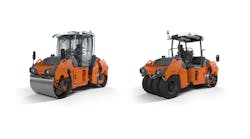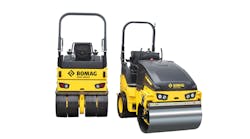Top combination rollers of 2023
The market for combination rollers is small, yet the machine offers equipment managers specific advantages in terms of operating costs and fleet deployment.
Combination rollers, with a steel front drum and pneumatic tires on the rear, provide two types of compaction in one machine. Utilization increases when one machine can replace two. Project operating costs go down as one machine works without a second unit sitting idle, and less transportation is required to move multiple units.
The machine specifications are similar to that of a tandem vibratory compactor: weight, rolling width, vibration frequency, amplitude, and total centrifugal force. These specs must satisfy the specific applications for which the combi is used.
Applications range from small asphalt jobs to larger jobs, and managers must consider both material and application. The properties of the asphalt itself affect whether rubber tires can be used. High temperatures, polymer modifieds, or rubber modifieds are some properties that can cause problems for rubber tires. A release agent will help in those situations, so manages may spec a separate tank mounted on the rear to hold a release agent or use a water tank to blend release agents in various ratios.
Most combination rollers use a separate tank and spray system for release agents, in addition to the steel drum’s water spray system, to keep tires from sticking to the asphalt they are compacting. If emulsions are used properly, tires will perform, and specialized asphalt mixes will require more attention to the amount and frequency of the release agent use. Diesel fuel, an old-school release agent, should never be used. Diesel degrades not only the tires, but also the mat itself.








